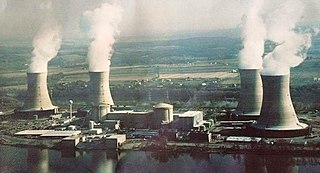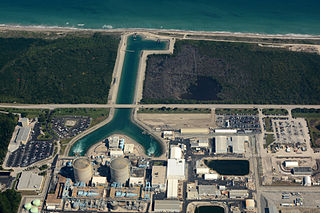
The Duane Arnold Energy Center (DAEC) was Iowa's only nuclear power plant. It is located on a 500-acre (200 ha) site on the west bank of the Cedar River, two miles (3.2 km) north-northeast of Palo, Iowa, USA, or eight miles (13 km) northwest of Cedar Rapids.

Davis–Besse Nuclear Power Station is a 894 megawatt (MW), nuclear power plant, located northeast of Oak Harbor, Ohio in Ottawa County, Ohio. It has a single pressurized water reactor. Davis–Besse is operated by Energy Harbor.

Indian Point Energy Center (I.P.E.C.) is a three-unit nuclear power plant station located in Buchanan, just south of Peekskill, in Westchester County, New York. It sits on the east bank of the Hudson River, about 36 miles (58 km) north of Midtown Manhattan. The facility has permanently ceased power operations as of April 30, 2021. Before its closure, the station's two operating reactors generated about 2,000 megawatts (MWe) of electrical power, about 25% of New York City's usage. The station is owned by Holtec International, and consists of three permanently deactivated reactors, Indian Point Units 1, 2, and 3. Units 2 and 3 were Westinghouse pressurized water reactors. Entergy purchased Unit 3 from the New York Power Authority in 2000 and Units 1 and 2 from Consolidated Edison in 2001.

Three Mile Island Nuclear Generating Station is a closed nuclear power plant on Three Mile Island in Londonderry Township, Dauphin County, Pennsylvania on Lake Frederic, a reservoir in the Susquehanna River just south of Harrisburg. It has two separate units, TMI-1 and TMI-2.

The San Onofre Nuclear Generating Station (SONGS) is a permanently closed nuclear power plant located south of San Clemente, California, on the Pacific coast, in Nuclear Regulatory Commission Region IV. The plant was shut down in 2013 after defects were found in replacement steam generators; it is currently in the process of decommissioning. The 2.2 GW of electricity supply lost when the plant shut down was replaced with 1.8 GW of new natural-gas fired power plants and 250 MW of energy storage projects.

Turkey Point Nuclear Generating Station is a nuclear and gas-fired power plant located on a 3,300-acre (1,300 ha) site two miles east of Homestead, Florida, United States, next to Biscayne National Park located about 25 miles (40 km) south of Miami, Florida near the southernmost edge of Miami-Dade County. The facility is owned by Florida Power & Light.

The Brunswick nuclear power plant, named for Brunswick County, North Carolina, covers 1,200 acres (490 ha) at 20 feet (6.1 m) above sea level about 5 miles (8.0 km) from the Atlantic Ocean. The site is adjacent to the town of Southport, North Carolina, and to wetlands and woodlands, and was opened in 1975.

The Sequoyah Nuclear Plant is a nuclear power plant located on 525 acres (212 ha) located 7 miles (11 km) east of Soddy-Daisy, Tennessee, and 20 miles (32 km) north of Chattanooga, abutting Chickamauga Lake, on the Tennessee River. The facility is owned and operated by the Tennessee Valley Authority (TVA).

The Alvin W. Vogtle Electric Generating Plant, also known as Plant Vogtle, is a four-unit nuclear power plant located in Burke County, near Waynesboro, Georgia, in the southeastern United States. It is named after a former Alabama Power and Southern Company board chairman, Alvin Vogtle.

The Virgil C. Summer Nuclear Power Station occupies a site near Jenkinsville, South Carolina, in Fairfield County, South Carolina, approximately 20 miles (32 km) northwest of Columbia.

River Bend Nuclear Generating Station is a nuclear power station on a 3,300-acre (1,300 ha) site near St. Francisville, Louisiana in West Feliciana Parish, approximately 30 miles (50 km) north of Baton Rouge. The station has one sixth generation General Electric boiling water reactor that has a nominal gross electric output of about 1010 MWe. Commercial operation began on June 16, 1986. In 2003, owners applied and were approved for a power upgrade of approximately 52 megawatts in 2003. The nameplate capacity is 974 MW.
The Waterford Steam Electric Station, Unit 3, also known as Waterford 3, is a nuclear power plant located on a 3,000-acre (1,200 ha) plot in Killona, Louisiana, in St. Charles Parish, about 25 miles (40 km) west of New Orleans.

St. Lucie Nuclear Power Plant is a twin nuclear power station located on Hutchinson Island, near Port St. Lucie in St. Lucie County, Florida. Both units are Combustion Engineering pressurized water reactors. Florida Power & Light commissioned the station in 1976 and continues to operate the station. Minor shares of Unit 2 are owned by the Florida Municipal Power Agency (8.81%) and the Orlando Utilities Commission (6.08%).

The AP1000 is a nuclear power plant designed and sold by Westinghouse Electric Company. The plant is a pressurized water reactor with improved use of passive nuclear safety and many design features intended to lower its capital cost and improve its economics.

Nuclear power in the United States is provided by 92 commercial reactors with a net capacity of 94.7 gigawatts (GW), with 61 pressurized water reactors and 31 boiling water reactors. In 2019, they produced a total of 809.41 terawatt-hours of electricity, which accounted for 20% of the nation's total electric energy generation. In 2018, nuclear comprised nearly 50 percent of US emission-free energy generation.

The Crystal River Energy Complex consists of seven power-generating plants on a 4,700-acre (1,900 ha) site near the mouth of the Crystal River in Citrus County, Florida. Crystal River 1, 2, 4, and 5 are fossil fuel power plants. Crystal River 3 was previously the sole nuclear power plant on the site (1977-2013). The Crystal River Combined Cycle site consists of two Mitsubishi gas turbines, which came on-line in 2018. The complex was developed in the early 1960s by the Florida Power Corporation and sold to Progress Energy Inc in 2000. Following Progress Energy's merger with Duke Energy in 2012, the facility is owned and operated by Duke Energy.

The McGuire Nuclear Station is a nuclear power plant located about 17 miles (27 km) northwest of Charlotte, North Carolina, on the state's largest lake, Lake Norman. It is a 32,500-acre (13,200 ha) lake created in 1963 by Duke Power for the Cowans Ford Hydroelectric Station. The McGuire units use the lake's water for cooling.
The Levy County Nuclear Power Plant was a proposed nuclear power plant in Levy County, Florida. Progress Energy Florida originally estimated that the reactors would cost $5 billion and would commence operation in 2016. It later became clear that the Levy County reactors would not have started operation until at least 2026. Since Progress filed its application for the new plant in 2008 demand for electricity had been growing very slowly, and natural gas prices were extremely low at the time. The utility estimated that the reactors would cost between $17 billion and $22 billion, not counting financing charges and cost overruns. According to economist Mark Cooper, opposition to the project has mounted, threatening a rerun of the 1970s and 1980s, when the majority of nuclear construction plans were canceled or abandoned.

The Catawba Nuclear Station is a nuclear power plant located on a 391-acre (158 ha) peninsula, called "Concord Peninsula", that reaches out into Lake Wylie, in York, South Carolina, USA. Catawba utilizes a pair of Westinghouse four-loop pressurized water reactors.

The Rooppur Nuclear Power Plant (Bengali: রূপপুর পারমাণবিক বিদ্যুৎকেন্দ্র) will be a 2.4 GWe nuclear power plant in Bangladesh. The nuclear power plant is being constructed at Rooppur of Ishwardi upazila in Pabna District, on the bank of the river Padma, 87 miles (140 km) west of Dhaka. It will be the country's first nuclear power plant, and the first of the two units is expected to go into operation in 2024. The VVER-1200/523 Nuclear reactor and critical infrastructures are being built by the Russian Rosatom State Atomic Energy Corporation. In the main construction period, the total number of employees will reach 12,500, including 2,500 specialists from Russia. It is expected to generate around 15% of the country's electricity when completed.



















